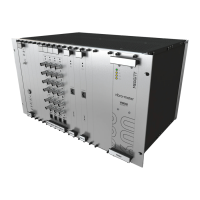Document reference MAMPS-HW/E HARDWARE MANUAL
Edition 18 - March 2022 VM600 machinery protection system (MPS)
9-37
Buffered (raw) outputs
CONFIGURATION OF MPC4 / IOC4T CARDS
9.6 Buffered (raw) outputs
The IOC4T has four differential outputs providing buffered raw signals. These outputs are:
• RAW 1H (high line) Connector J3, Terminal 9
• RAW 1L (low line) Connector J3, Terminal 10
• RAW 2H (high line) Connector J3, Terminal 11
• RAW 2L (low line) Connector J3, Terminal 12
• RAW 3H (high line) Connector J3, Terminal 13
• RAW 3L (low line) Connector J3, Terminal 14
• RAW 4H (high line) Connector J3, Terminal 15
• RAW 4L (low line) Connector J3, Terminal 16.
The buffered raw signals are derived from the signals coming from the sensors connected to
measurement channels 1 to 4 (connector J1 of the IOC4T card).
These buffered raw signals are identical to those available on the BNC connectors on the
front panel of the corresponding MPC4 card.
It is important to note that the buffered raw output signals use circuits that are protected
against permanent short-circuits (relative to ground) and moderate voltage injections
(up to ±12 V) – for each output (RAW_nH) and corresponding return line (RAW_nL). Each
buffered raw signal return line (RAW_nL) is protected by a resettable fuse, therefore, after a
short-circuit or voltage injection event, a cool down time may be required in order to restore
the functionality (that is, availability of the buffered (raw) output).
NOTE: The buffered (raw) outputs are not galvanically isolated, so the absence of
ground loops cannot be guaranteed. Unless the absence of such ground loops is
verified for an application, it is recommended to use external galvanic separation.
Refer to the MPC4 machinery protection card data sheet for further specifications.
9.7 DSI control inputs (DB, TM, AR)
These DSI control inputs are normally floating (open circuit).
To activate an input, connect it to the RET terminal (Connector J3, Terminal 8). This closes
the contact.
The input function as follows:
• Danger Bypass (DB) – A closed contact between the DB and RET terminals allows the
operator to inhibit the danger relay outputs.
• Trip Multiply (TM) – When there is a closed contact between the TM and RET terminals,
alarm levels are multiplied by a scale factor (software defined).
When TM is open, the scale factor is not taken into account.
• Alarm Reset (AR) – A closed contact between AR and RET inputs resets (clears) any
latched alarms.
NOTE: An externally generated Alarm Reset (AR) should be an aperiodic pulse-type
signal, that is, it should not be activated continuously.
The discrete signal interface (DSI) inputs (DB, TM and AR) share a common reference/return
with the DC outputs (DC OUT 1, DC OUT 2, DC OUT 3 and DC OUT 4). This common

